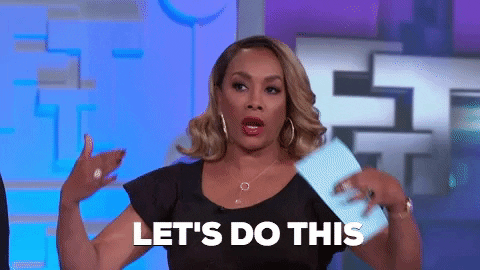Interviewing Sucks.
Especially if you’re the hiring manager. Why? Because in addition to the fifty-leven million things on your plate, you now have to try and swipe right on the perfect candidate who has the right skills, professionalism, and personality to join the team. There’s a lot of pressure to make the right hire. Your team, your work, and your reputation are counting on you to make the right decision.
Not to mention that if you have an open position that means more work for you, your team, or both. According to SHRM, it takes an average of 42 days to fill an open position. That’s a lot of time and lost productivity.
And let’s don’t even talk about the time, money, and morale that’s lost on a bad hire (#ifyouknowyouknow).

Quiet as it’s kept, being a hiring manager or business owner, doesn’t always make you an expert interviewer. When’s the last time you received training on how to write a job description, ask the right interview questions, or spot a con-artist in a suit? #I'llwait
Well today, you’re in luck! I'm teaching you some easy yet intentional ways to simplify your hiring process and hire employees you won’t want to fire later.

STEP 1: Determine your hiring criteria
Just like on any team, you need different people to play different positions, so the first step to hiring the right employee is being really, really clear about what you need the new employee to support, contribute to, and or lead. Here are few questions to help you brainstorm:
·What do I need to know in order to make the right hiring decision?
· What type of experiences does this person need to have?
· What skills do they need to be successful?
· What are some key personality traits or mindsets that I’m looking for?
· What would make someone unsuccessful in this role?
Do you need someone who can crank out a high volume of work? Maybe you are looking for someone who can lead others and step into a leadership role.
Think about the current team (even if it’s just you), do you need the new hire to have similar skills or would it be better if they had a slightly different skill set and personality type?
Once you know what you’re looking for, that becomes your hiring criteria. You can prepare a hiring rubric to make sure your interviews are fair and objective, plus it helps you not get finessed by interviewers who are nice and charming but don’t actually have the skills required to do the job.
Here’s a sample version from SHRM but you can easily create your own:
Step 2: Write/update the job description
You've already identified your hiring criteria in step 1 so now all you need to do is translate that into a job description that attracts the kind of employee you want to hire.

Pro Tip: If you work in an organization with pre-written job descriptions talk to your recruiter to see if you can incorporate some of your hiring criteria.
Here’s how to write a great job description:
· Skip the fluff. Most job descriptions say a whole lot without saying much.
· Use clear concise language to give an overview of the actual role, key responsibilities, and key skills required.
· Be sure to insert your company’s tone and culture.
Step 3: Prepare your interview questions & conduct the interview
When it comes to preparing interview questions, skip Googling the “best interview questions” and prepare your own.

Yep, you read that right. Because you’ve taken the time to think through what you’re looking for in a candidate you’ll want to equally take the time to come up with questions that uncover the skills and experiences you are looking for.
You don’t want to hire someone good at interviewing (they probably Googled those same questions).
Generic questions get you generic answers.
Don’t overthink the questions or stress out trying to think of what to ask. Just start with your hiring criteria then go from there. Here’s an example:
Hiring criteria #1: I need someone who is really good at using Excel to create reports.
Instead of: Do you know excel?
Ask: “What are some formulas and functions you commonly use in Excel?”
Pro Tip: Go deeper, ask follow up questions to their responses if necessary, e.g.
· “Were you responsible for creating the Excel reporting or were you using/refreshing a pre-designed template?
· “Who was the recipient of those reports? How did they use the reporting?”
Avoid – yes/no or rate yourself on a scale of 1-10 especially for specialized skills. People can overestimate their skills or straight-up lie, *it happens*
Speaking of questions – do not just drill the person. Make it conversational. If you want to get the best information, help put the candidate at ease by making the interview as conversational as possible. It will also help you get a “feel” for the potential hire.
And another thing, don’t sell dreams and don’t play games. Be honest about the work, the salary, the commitment, even the shortcomings. If there’s a busy season, say that.
Don’t feed someone BS about being able to promote from within if you know good and darn well ain’t nobody been promoted.

Finally, set a clear timeline of when you expect to make a decision and when they should expect to hear back….and stick to it! It’s hard enough out here, don’t ghost your candidates.
Step 4: Go further than just Q&A interviews
Interviews can go behind questions and answers. A great way to see if someone is the right hire is to simulate scenarios they’ll face on the job. If someone will be coding etc. prepare a short technical interview where they actually have to code something. If the role has an emphasis on public speaking, ask the candidate to prepare a 5-minute presentation on the topic of their choice.
Pro Tip: Do not ask interviewees to give you free work/consulting. That’s not cool. Your technical interview should be illustrative, not free labor.
Another way to take an interview beyond just Q&A is to invite the candidate to lunch or coffee with the team. This is particularly helpful in a collaborative environment. Getting the candidate out of a traditional office environment will often reveal their true personality, not just their “interview persona.” And you’ll get to see if the potential hire vibes with the team.
Step 5: Trust your gut
There’s a reason you’re in the position to make a hiring decision. Don’t ignore red flags, you’ll always regret it in the end. And while there is no such thing as the perfect candidate, you’ll know when someone has the right mix of skills and personality for your team and when they won’t.
Hiring and interviewing takes practice. Give yourself grace to not be perfect at first. As leaders, people are our most important asset, so the most important thing is that you approach hiring from a place of clarity, preparedness, and transparency.
Good luck!
Sources:
Hiring Rubric: https://www.shrm.org/resourcesandtools/tools-and-samples/hr-forms/pages/1cms_002131.aspx
Time to Hire: https://www.shrm.org/about-shrm/press-room/press-releases/pages/human-capital-benchmarking-report.aspx

